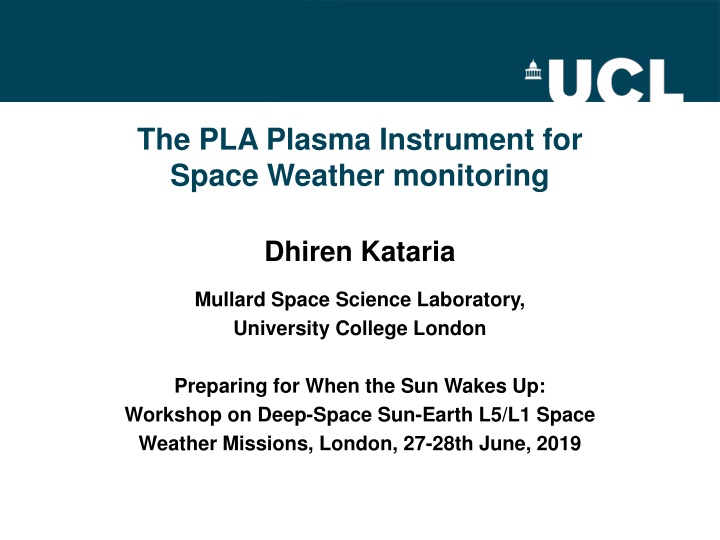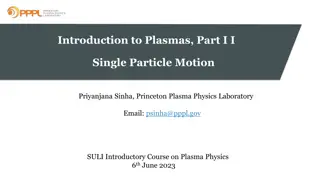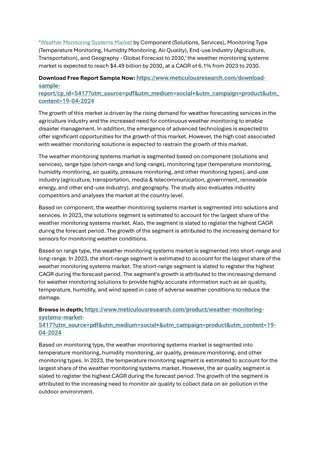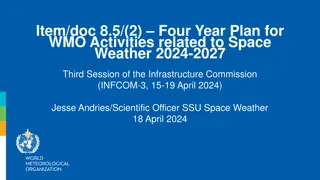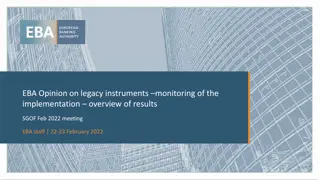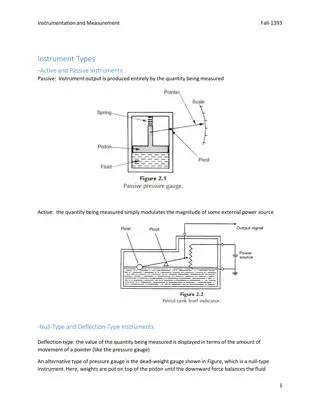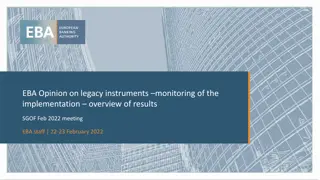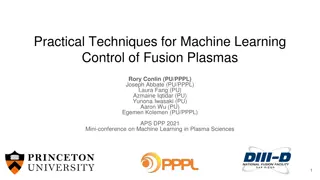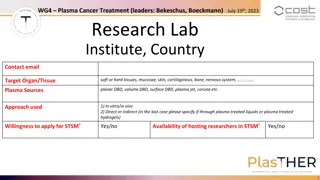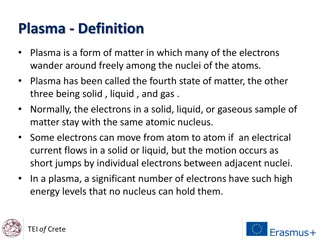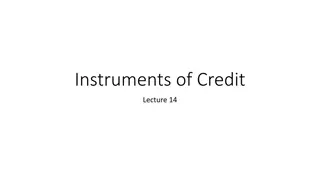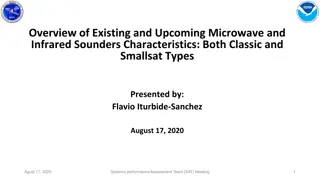Advancements in Plasma Instruments for Space Weather Monitoring
Explore the latest developments in plasma instruments for space weather monitoring, including the PLA Plasma Instrument and MSSL Heritage in Plasma Instruments. These instruments enable precise measurement of plasma parameters in deep space, supporting missions to study solar wind, ion densities, and temperatures with high accuracy. Current missions and space weather science are also highlighted, showcasing key requirements for plasma ion measurements in space.
Download Presentation

Please find below an Image/Link to download the presentation.
The content on the website is provided AS IS for your information and personal use only. It may not be sold, licensed, or shared on other websites without obtaining consent from the author.If you encounter any issues during the download, it is possible that the publisher has removed the file from their server.
You are allowed to download the files provided on this website for personal or commercial use, subject to the condition that they are used lawfully. All files are the property of their respective owners.
The content on the website is provided AS IS for your information and personal use only. It may not be sold, licensed, or shared on other websites without obtaining consent from the author.
E N D
Presentation Transcript
The PLA Plasma Instrument for Space Weather monitoring Dhiren Kataria Mullard Space Science Laboratory, University College London Preparing for When the Sun Wakes Up: Workshop on Deep-Space Sun-Earth L5/L1 Space Weather Missions, London, 27-28th June, 2019
MSSL Heritage in Plasma Instruments Cassini ELS Cluster PEACE Current Electron Top Hat Instruments Cassini CAPS-ELS (2005-2016) Cluster PEACE (2001-2020) Solar Orbiter EAS (2020-) Heritage in ion instruments Giotto JPA (solar wind and magnetospheric ions) AMPTE JPA (solar wind and magnetospheric ions) MARS 96 FONEMA (Martian ions mass/energy) ChaPS and QB50 INMS (cold ions in LEO, 2015-2018) Recent work on solar wind analysers for space weather LGR PLA LIA for SMILE SWAN for Sunjammer (mission cancelled) Reduced scale PEACE LEEA Solar Orbiter EAS Ion and Neutral Mass Spectrometers for QB50 TechDemoSat ChaPS
MSSL Heritage in Plasma Instruments Cassini ELS Cluster PEACE Current Electron Top Hat Instruments Cassini CAPS-ELS (2005-2016) Cluster PEACE (2001-2020) Solar Orbiter EAS (2020-) Heritage in ion instruments Giotto JPA (solar wind and magnetospheric ions) AMPTE JPA (solar wind and magnetospheric ions) MARS 96 FONEMA (Martian ions mass/energy) ChaPS and QB50 INMS (cold ions in LEO, 2015-2018) Recent work on solar wind analysers for space weather LGR PLA LIA for SMILE SWAN for Sunjammer (mission cancelled) Reduced scale PEACE LEEA Solar Orbiter EAS Ion and Neutral Mass Spectrometers for QB50 TechDemoSat ChaPS
Current missions and Space Weather Science Source to sink Background Image credit: NASA
Current missions and Space Weather Science Source to sink DISCOVERER, CIRCE Background Image credit: NASA
Key Requirements - L1/L5 Plasma Ion Measurement At least one measurement of the solar wind velocity vector (Vx, Vy, Vz), average ion temperature, and ion density moments every 1 seconds Velocity range 200 to 2500 km/sec with 5% relative accuracy Temperature range: 40,000 to 1,000,000 K with 20% relative accuracy Density range: 0.2 to 150 cm-3, with 5% absolute accuracy
LGR PLA Design Based on Solar Orbiter EAS top-hat design shown in photo Solar Orbiter EAS Key changes required: Ions instead of electrons Maximum energy from 5 keV to 38 keV Lower geometric factor, large dynamic range Solar Orbiter EAS Analyser Head
LGR PLA Design Axis of rotational symmetry symmetry Axis of rotational Electrostatic Aperture Deflection Plates Deflection Plates Deflection Plates Deflection Plates Electrostatic Aperture Electrostatic Aperture Electrostatic Aperture Based on Solar Orbiter EAS top-hat design shown in photo 0V 0V +HV Variable GF system Variable GF system Solar Orbiter EAS e e i + HV + HV -HV Key changes required: Ions instead of electrons Maximum energy 5 keV to 38 keV Lower geometric factor, large dynamic range -HV + HV + HV + HV + HV + HV + HV + HV + HV Hemispheric Hemispheric Electrostatic Electrostatic Analyser system Analyser system Electron Trajectory Trajectory Electron Detector (e.g. MCP, CEM) (e.g. MCP, CEM) Detector Solar Orbiter EAS Analyser Head
Performance parameters EAS (electrons) - PLA (ions) Parameter Mass Range/resolution Species Range (3.8 kV HV) Resolution EAS (28.28 mm) Electrons PLA (29.10 mm) H, He 1 5000 eV (2 kV) Energy 0.05 36 keV/q 13.05% 8.37% ( E/E) Analyzer constant (eV/V) Range (AZ) 6.18 9.52 360 Angle -20 - +25 22.5 45 with energy cut off 16 steps Range (EL) 45 Range scan (EL) Angular Resolution (AZ EL) Pixel Field of view Resolution Normal mode Burst mode Per pixel (cm2 sr eV/eV) 16 steps 11.25 x 3 - 11.4 5 x 2 - 7.2 11.25 x 3 - 11.4 5 x 2 - 7.2 1 s moments 60 s 3D TBD Variable, < 7.8 x10-6 3s / 10 s Temporal 0.125 s Variable, < 6.5 x 10-5 Geometri c factor
Key challenges Lifetime and Reliability Measurement accuracy across full measurement range Instrument saturation under extreme conditions Signal to noise under extreme conditions
Phase B1 pEQM pre-developments To address the TRL of the following subsystems Optics High Voltage Supply Detector sub-system EAS PLA Inner hemisphere radius 28.28 mm Inner hemisphere radius between 28.28 and 29.10 mm Optics Ebanol-C Ebanol-C or flight heritage alternative UV coatings Single polarity, +2 kV analyser sweep voltage. 2 stages added to Cockcroft- Walton chain on same board Supplied by LPP, designed for electrons Dual polarity, 4 kV analyser sweep voltage HVPS Supplied by MSSL, designed for ions Detector system Dual Head structure, At end of boom, in spacecraft shadow Single Head structure Sun facing, with thermal shield Structure Accommodation and thermal
Modelling Solar Wind performance Slow to extreme 300-2500 km/s Tenuous to dense 1-100 particles/cc Cold to hot 10-1000 eV Modelling work to ensure Meet accuracies over measurement range Not saturate during most extreme space weather events Robert Wicks, Georgios Nicolaou, Jonathan Rae
Current Status and Summary Strong heritage - in-situ particles Instrument science, space weather science and engineering State-of-the-art Instrument Suite under study International consortium with strong heritage Phase B1 study nearing completion pEQM pre-development, performance modelling, systems engineering Presentation to ESA ministerial in Nov. Bridge phase and then Phase B2/C/D April 2020
In-situ Working Group Plan to bring together the working group more effectively over the next several months Propose perhaps an ISSI or similar activity Smaller group, focussed on in-situ measurements Relevant expertise in instrument science, space weather science and forecasters Aim to pull the book together before launch Overall need but certainly very valuable for end users d.kataria@ucl.ac.uk
L5 in-situ suite/PLA study group Project Leads Jonathan Rae (Plasma Science), Dhiren (Instrument Science) Project Manager: Richard Cole, Chris Brockley Blatt Ground System: Bob Bentley System Engineer: Hubert Hu System Engineering Support: Barry Hancock Mechanical Engineering: Duncan Rust, Berend Winter Thermal: Keith Wells Science support: Rob Wicks, Andrew Fazakerley, Georgios Nicolaou
PLA status Instrument design Proceeding to bread-boarding phase with radius of 29.1 mm Flight representative head build EAS optics with changed IH radius Breadboard Detector readout system Voltage (6.18) Voltage (9.5) Voltage (11.4) 1.618123 1.052632 8.090615 5.263158 80.90615 52.63158 161.8123 105.2632 1618.123 1052.632 2993.528 1947.368 4045.307 2631.579 5339.806 3473.684 6148.867 4000.0 6957.929 4526.316 7605.178 4947.368 Energy 10 50 500 1000 10000 18500 25000 33000 38000 43000 47000 Velocity (km/s) 4.38E+01 9.79E+01 3.10E+02 4.38E+02 1.39E+03 1.88E+03 2.19E+03 2.52E+03 2.70E+03 2.87E+03 3.00E+03 0.877193 4.385965 43.85965 87.7193 877.193 1622.807 2192.982 2894.737 3333.333 3771.93 4122.807
